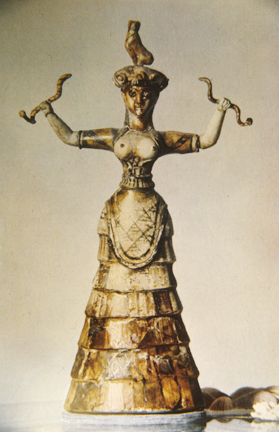This 'Earth Goddess' was recovered from a subterranean chamber among other treasures from the palace at Knossus, Crete. Many such figures have been found, with the goddess depicted in just this way. Constructed of wheel thrown parts and assembled, the figure stands at 30cm. Its meaning is unclear, but it suggests ritual significance, and is possibly a cult figure or fertility goddess. These female figures are always depicted as bare breasted, holding snakes above the head, with a bird on the head, and wearing floor length skirts.
Around 1450 BCE, a series of devastating earthquakes virtually destroyed the palaces and political structure of Crete, leaving it vulnerable to invasion and conquer by the Mycenaeans of mainland Greece who would extensively copy the art and culture of the Minoans. One such major disaster befell nearby Thera (now called Santorini) and half the island blew off, burying most of the remaining part of the island under ash. These natural disasters are thought by some to be the origin of the Atlantis story, in which palaces and cities sunk into the sea, lingering only in myth and imagination.

Earth Goddess with snakes, Earthenware, Middle Minoan, 1600-1580 BCE


